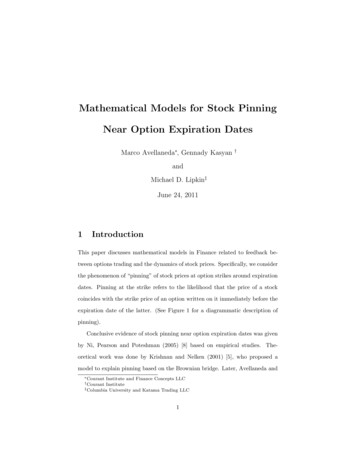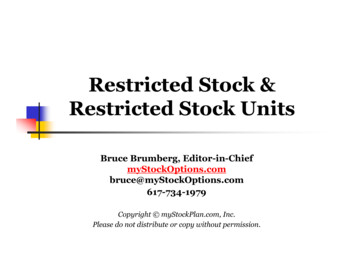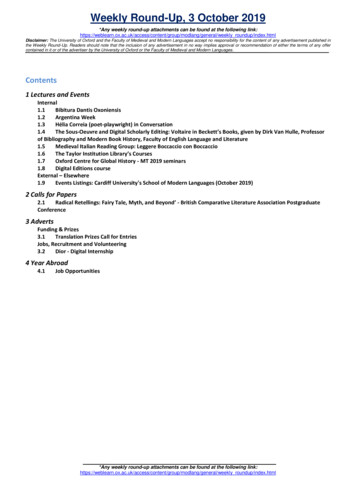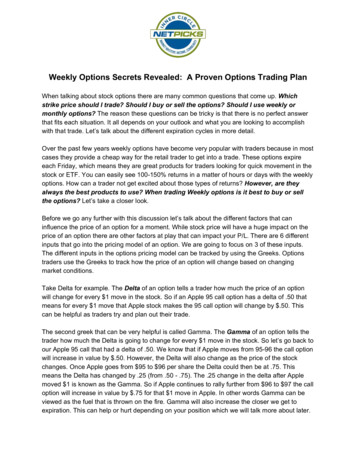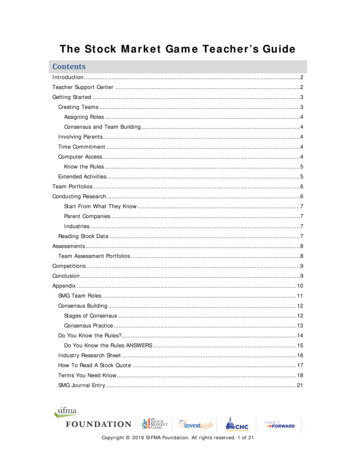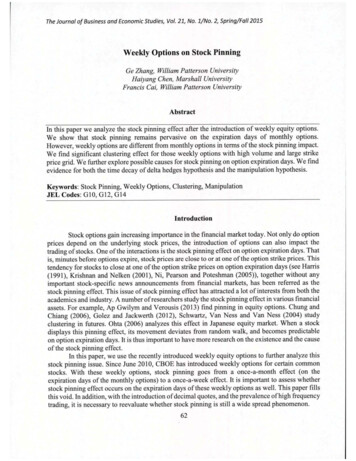
Transcription
The Journal o f Business and Economic Studies, Vol. 21, No. 1/No. 2, Spring/Fall 2015Weekly Options on Stock PinningGe Zhang, William Patterson UniversityHaiyang Chen, Marshall UniversityFrancis Cai, William Patterson UniversityAbstractIn this paper we analyze the stock pinning effect after the introduction o f weekly equity options.We show that stock pinning remains pervasive on the expiration days o f monthly options.However, weekly options are different from monthly options in terms o f the stock pinning impact.We find significant clustering effect for those weekly options with high volume and large strikeprice grid. We further explore possible causes for stock pinning on option expiration days. We findevidence for both the time decay of delta hedges hypothesis and the manipulation hypothesis.Keywords: Stock Pinning, Weekly Options, Clustering, ManipulationJEL Codes: G10, G12, G14IntroductionStock options gain increasing importance in the financial market today. Not only do optionprices depend on the underlying stock prices, the introduction o f options can also impact thetrading of stocks. One of the interactions is the stock pinning effect on option expiration days. Thatis, minutes before options expire, stock prices are close to or at one o f the option strike prices. Thistendency for stocks to close at one o f the option strike prices on option expiration days (see Harris(1991), Krishnan and Nelken (2001), Ni, Pearson and Poteshman (2005)), together without anyimportant stock-specific news announcements from financial markets, has been referred as thestock pinning effect. This issue of stock pinning effect has attracted a lot o f interests from both theacademics and industry. A number of researchers study the stock pinning effect in various financialassets. For example, Ap Gwilym and Verousis (2013) find pinning in equity options. Chung andChiang (2006), Golez and Jackwerth (2012), Schwartz, Van Ness and Van Ness (2004) studyclustering in futures. Ohta (2006) analyzes this effect in Japanese equity market. When a stockdisplays this pinning effect, its movement deviates from random walk, and becomes predictableon option expiration days. It is thus important to have more research on the existence and the causeof the stock pinning effect.In this paper, we use the recently introduced weekly equity options to further analyze thisstock pinning issue. Since June 2010, CBOE has introduced weekly options for certain commonstocks. With these weekly options, stock pinning goes from a once-a-month effect (on theexpiration days o f the monthly options) to a once-a-week effect. It is important to assess whetherstock pinning effect occurs on the expiration days o f these weekly options as well. This paper fillsthis void. In addition, with the introduction of decimal quotes, and the prevalence of high frequencytrading, it is necessary to reevaluate whether stock pinning is still a wide spread phenomenon.62
The Journal o f Business and Economic Studies, Vol. 21, No. 1/No. 2, Spring/Fall 2015We show that stock pinning is still pervasive on the expiration days o f monthly optionsafter the introduction o f weekly options. However stock pinning effect is not significant on theexpiration days o f weekly options. Part o f the reason is that weekly options have smaller tradingvolumes and open interests than monthly options. Even after we focus only on those weeklyoptions with large trading volumes, the pinning effect is still weaker for weekly options.Next we study possible causes for stock pinning on option expiration days. Avellaneda andLipkin (2003) argue that the time decay o f delta hedges o f long option positions leads to stockpinning. Using the same logic, Golez and Jackwerth (2012) point out that market makers inS&P500 future options market hold net short option positions, and their delta hedging trades causethe future price to move away from option strike price. We find similar evidence supporting thishypothesis in the equity market. The trading volume o f at-the-money options on option expirationdays has a positive effect on the probability o f stock pinning. This shows that the closing o f optionpositions reduces the delta hedges o f the market makers, and leads to increasing likelihood o f stockpinning.Another cause for stock pinning is the market manipulation mechanism o f Ni, Pearson, andPoteshman (2005). If option market makers hold net short positions, market makers profit the mostwhen the stock price is pinned to a certain strike price. Hence market makers or option sellers haveincentive to manipulate the stock price toward option strike price. It is debatable whether thesetraders have such power to manipulate the price. However, if manipulation does exist, this kind ofmanipulation would be short lived, and we would observe negative autocorrelation between thereturns on the expiration day and the day after the expiration day. We find such negativeautocorrelation from the subsample where we observe stock pinning on the option expiration days.Thus we provide some evidence o f manipulation in the stock market in connection to optiontrading activities.This paper contributes to the literature by extending the literature on stock pinning toweekly options. By analyzing stocks with both monthly options and weekly options, we canachieve a better understanding on how option trading impacts stock trading. We also extend theliterature on possible causes for stock pinning effect on option expiration days. We find evidencefor both the time decay o f delta hedges hypothesis and the manipulation hypothesis. Our studyprovides interesting implications o f the introduction o f new option contracts to compliment stocktrading.This paper is organized as follows: Section 2 presents the data, and Section 3 studies thestock pinning effect. Section 4 studies the possible causes for stock pinning. Section 5 concludesthe paper.DataWe obtain the data on stocks with weekly equity options from Market Data Express. Thefirst weekly option o f a common stock was introduced by CBOE on June 25, 2010. Our data periodends at the end o f 2012. We obtain the expiration dates, strike prices, open interests and tradingvolumes o f the options from the same data source. The stock price information is obtained fromCRSP.We only study common stocks in this study. While CBOE has introduced weekly optionsfor exchange traded funds (ETFs), we do not include those since the price o f ETFs depend on otherfinancial assets and the relation between option trading and clustering o f ETFs is less clear. We63
The Journal o f Business and Economic Studies, Vol. 21, No. 1/No. 2, Spring/Fall 2015require that the options have reasonable trading volumes and enough weekly options to beincluded. In particular, we require that sum o f the trading volumes o f the two at-the-money callsand the two at-the-money puts on the Thursday right before the option expiration to be at least 40.In addition, a stock must have at least 6 weekly option expiration dates to be included in the sample.For any one stock, there are many options with different strike prices traded. In fact, more than93% o f the stocks and expiration dates have strike price grids o f 1, 2.5, or 5. Less common gridsare 0.5 and 10. There are some other strike prices grids which are results o f stock split. In thisstudy, we focus on the stocks and expiration dates where the option strike price grids are 1, 2.5, or5. Altogether we have 93 common stocks with weekly options traded in the period from 2010 to2012. We have 6,301 stock-expiration dates, out o f which 2,748 are for monthly options and 3,553are for weekly options.Stock Pinning ResultsMonthly options expire on Saturday after the third Friday o f the month. Since there is notrading on Saturday, the closing price on the third Friday of the month is effectively the last tradedstock price before option expiration. Weekly options expire on Friday and again the closing priceon Friday is the last traded stock price before option expiration. Thus we focus the pinning effectof the closing price on Friday toward existing option strike prices. Following Ni, Pearson andPoteshman (2005), we define the stock pinning dummy (Dpin) to 1 if the stock closes within 0,125 of a strike price. For example, suppose a stock is traded at around 400 per share and itsoptions have strike prices from 200 to 600 with a grid size of 5. If the closing price o f the stockfalls in the range o f (394.875, 395.125), (399.875, 400,125), (404.875, 405.125), or any othersimilar ranges centered on an existing option strike price, we set the dummy variable (Dpin) to 1,and 0 otherwise. We report all our results using 0,125 for the cutoff point for the definition ofstock pinning. That is, we define a stock is pinned to a strike price if the stock close price fallsbetween strike price minus 0.125 and strike price plus 0.125. Our results do not changequalitatively if we use 0.25 as the cutoff point.For the option expiration day, we select two trading days before the expiration, and twotrading days after the expiration to check how the stock price clusters around option strike priceon days with no option expiring. We only focus on the two days before and two days after becausethe introduction o f weekly options makes nearly every Friday an option expiration day. The 93stocks in our sample have different grid sizes of strike prices. Our definition of the stock clusteringis that the stock closes within 0,125 of a strike price. Obviously, a stock with a small strike gridwould have a higher probability to have the stock closing with 0,125 of a strike price than a stockwith a large strike grid. For this reason, we report the clustering percentages for different strikegrids.Table 1 reports the fraction of days when the stock close price pins to an option strike price,for option expiration days, as well as days before and after option expiration days. Panel A presentsresults for all options. Clearly, on option expiration days, it is more likely for the stock to clusteron an option strike price. For example, among all stocks whose option strike prices have grid of 5, 8.2% o f the time the stock pins to an option strike price on option expiration days, while thispercentage is never above 6% on the days before and after option expiration days. This result isconsistent with Ni, Pearson and Poteshman (2005). Using a most recent data sample, we show that64
The Journal o f Business and Economic Studies, Vol. 21, No. 1/No. 2, Spring/Fall 2015stock clustering effect still exists and the stock close price has a tendency to pin to an option strikeprice on option expiration days.Panel B and Panel C studies the monthly options and weekly options separately. Weobserve that the clustering effect on expiration days o f weekly options is not as pronounced as theclustering effect on expiration days o f monthly options. While all stocks show somewhat clusteringeffect to option strike prices, the fraction is much higher for monthly option expiration days.Among all stocks whose option strike prices have grid o f 5, 6.9% o f the time the stock pins to anoption strike price on weekly option expiration days, while 10% o f the time the stock pins to anoption strike price on monthly option expiration days. On days when no options expire, thispercentage stays around 6%. Clearly the expiration o f monthly options has a stronger impact onthe stock clustering effect. Later, we will investigate this result using regression analysis.Table 1. Summary o f Stock Pinning on Option Strike PricesPanel A. All Options(All Grids)ExpiringDay - 2ExpiringDay - 1ExpiringDayExpiringDay 1ExpiringDay 20.1630.1590.1860.1610.159(Grid l)0.2530.2450.2750.2460.257(Grid 2.5)(Grid 51(Grid 2.5)(Grid 47(Grid 2.5)(Grid 54Panel B. Monthly Options(All Grids)ExpiringDay - 2ExpiringDay - 1ExpiringDayExpiringDay 1ExpiringDay 20.1780.1590.2020.1630.160(Grid l)0.2710.2430.2850.2440.254Panel C. Weekly Options(All Grids)ExpiringDay - 2ExpiringDay - 1ExpiringDayExpiringDay 1ExpiringDay 20.1500.1590.1740.1600.159(Grid l)0.2390.2470.2670.2470.259Table 1 presents the fraction of days when the closing price of a stock falls within 0,125 of an option strike price.We show the fraction on the option expiring day, two days before the expiration, and two days after the expiration.We report results for option strike price grids of 1, 2.5, and 5 respectively, and together (All Grids).65
The Journal o f Business and Economic Studies, Vol. 21, No. 1/No. 2, Spring/Fall 2015To investigate the possible reasons for stock pinning, we obtain several additional optionvariables. In particular, we obtain the trading volume o f the at-the-money calls and puts onexpiration day (VolExp) and the open interest o f the at-the-money calls and puts on the day beforethe expiration day (Openlnt). The open interest is one day before the expiration day because weonly have daily data reflecting the information at the close o f the trading day. The open interest atthe close of the expiration day is in general zero. Given that both the volume and open interest arehighly skewed, we use their corresponding logarithms (LogVol and LogOI) in regression analysis.The other variable we obtain is the volatility o f the stock. Following Dijk and Martens (2007), wecalculate the daily volatility (Sigma) from the trading range o f the stock during the day as follows:Sigma (Log(Pricehigh) - Log(Price low))2/(4 Log(2))(1)We multiply the volatility by 100 to make the numbers reasonably scaled. The volatility o fthe stock on the expiration day (Sigma) is o f particular interest to us.Table 2 reports these variables for the monthly options sample and the weekly optionsamples separately. We also test whether the difference between the two samples is significant ornot. A general theme of Table 2 is that the trading volume and open interest o f monthly optionsare higher than those o f weekly options. This result is not surprising given weekly options areintroduced more recently and they are typically traded for a short period of time. On the otherhand, monthly optionsTable 2. Comparison o f Monthly Options and Weekly OptionsExpiration Dates o f Monthly Expiration Dates o f WeeklyO p tio n s OptionsMedianStdMedian MeanStdVariable 9588,590.84,25526,128VolExp11,2454,13817,896 7,663.6 ***-4.19***-25.98***-1.72****-14.44-52.92***-1AA .47***Table 2 presents the mean (Mean), standard deviation (Std) and median (Median) of option variables from monthlyoptions and weekly options. Option variables include the dummy variable for pinning to a strike price (Dpin), thetrading volume of the at-the-money calls and puts on expiration day (VolExp) and its logarithm (LogVol), the openinterest of the at-the-money calls and puts on the day before the expiration day (Openlnt) and its logarithm (LogOI),the volatility of the stock on the expiration day (Sigma). The volatility is multiplied by 100. The t-stat tests whetherthe means between the two samples are significantly different. The z-stat is a Wilcoxon test on whether the mediansof the two samples are significantly different. ***, **, * indicate significance at 1%, 5%, and 10% level, respectivelyexist for a long time, and they are available for trading for a much longer period. However, we note that weekly optionsare quite active. The median volume sum of the four at-the-money weekly options (two calls and two puts) is 2,260,about half o f 4,255, which is the corresponding median volume of the four at-the-money monthly options. The medianopen interest of the four weekly options the day before the expiration day is 4,138, about a quarter of 17,896, whichis the corresponding number for monthly options.66
The Journal o f Business and Economic Studies, Vol. 21, No. 1/No. 2, Spring/Fall 2015We run logistic regressions to investigate the impact o f option expiration on stockclustering. We include stocks on the days o f option expiration, two days before the expiration andtwo days after the expiration. The dependent variable is Dpin, the dummy variable which is 1 ifthe closing stock price falls in a small band around an option strike price. Table 1 already showsthat the mean o f Dpin is greater on option expiration days. Running the regression allows us to testthe significance o f the impact and the difference between weekly options and monthly options.Panel A o f Table 3 uses the dummy variable indicating the option expiration day (Dexpire)as the only control variable in the logistic regression. We find significant and positive coefficientsfor Dexpire in the whole sample and in each o f three subsamples with different option grids. Thisresult is consistent with the result in Table 1 and existing literature from Ni, Pearson andPoteshman (2005), Ohta (2006), Ap Gwilym and Verousis (2013), etc. The expiration o f optionscontributes positively to the probability o f stock clustering on option strike prices.In Panel B, we change the control variables to two dummy variables: a dummy variableindicating the expiration day of monthly options (Dmonthly), and a dummy variable indicating theexpiration day of weekly options (Dweekly). This way we can investigate whether weekly optionshave the same impact as monthly options. The results show that the expiration o f weekly optionsdoes not have the same impact as the expiration o f monthly options. In the full sample, thecoefficient o f Dmonthly is 0.282, while the coefficient o f Dweekly is 0.098. Although thecoefficient o f Dweekly is significant at 5% level, it is about a third o f magnitude o f the coefficientof Dmonthly. In regressions with fixed grid size, the coefficients o f Dmonthly are still positive andstatistically significant, but the coefficients o f Dweekly lose their significance. Only in thesubsample where the option grid size equals 2.5, the coefficient o f Dweekly is significant at 10%level. The magnitude o f Dweekly coefficients is much smaller than Dmontly coefficients. All theseresults show that weekly options are different from monthly options in terms o f the stock clusteringimpact.Considering the results from Table 2, one may argue that the reason that weekly optionshave smaller impact is the lack of trading volume and open interest o f these options. If options arelisted but there is no investor interest in these options, it would not be surprising for these optionsto have little impact on stock trading activities. In Panel C, we run the same logistic regression asin Panel B, but in a subsample of those stocks whose option volumes are above the median o f thewhole sample. This way we only concentrate on those expiration days when the options haveattracted large investor interest. The coefficients of Dweekly in these regressions become largerand significant, but they are still smaller than the coefficients o f Dmonthly in general. Anotherinteresting observation from Panel C is that the clustering effect appears to be stronger for largeoption grids. When the option strike price grid is 1, the clustering effect is quite muted. When theoption strike price grid is 5, it is significant for both monthly options and weekly options. Hence,while weekly options are in general different from monthly options in the contribution to stockpinning, those weekly options with large volume and investor interest have a big impact on stockpinning.Delta HedgingPossible Reasons for Stock PinningIn this section, we study possible reasons for stock pinning. Avellaneda and Lipkin (2003)argue that the time decay o f delta hedges o f long option positions leads to stock pinning. Forexample, suppose an investor who holds long call option positions engages in delta hedge. For67
The Journal o f Business and Economic Studies, Vol. 21, No. 1/No. 2, Spring/Fall 2015long call positions, the delta hedge is negative (a short position o f stock). When the stock price isabove the option strike, as the call position approaches expiration, the delta hedge needs to be morenegative, and approaches -1 at expiration. This means that the investor would have to sell morestocks when the stock price is above the option strike price and this selling pressure may push thestock price down to the strike price. Similarly, when the stock price is below the option strike, asthe call position approached expiration, the delta hedge needs to move close to zero. This meansthat the investor would have to close short position (i.e. buy stocks) when the stock price is belowthe option strike. This buying pressure would push the stock price higher toward the option strikeprice. Hence the delta hedges o f long option positions would cause pinning.Table 3. Logistic Regressions o f Stock Pinning around Option Expiration DaysPanel A. Dependent variable: Dpin(Grid 5)(Grid 2.5)(All Grids)(G rid 0.05%0.09%Pseudo R2764082621429330195NobsPanel B. Dependent variable: Dpin(Grid 5)(Grid 2.5)(G rid l)(All 51%0.29%0.05%0.12%Pseudo R2764082621429330195NobsPanel C. Dependent variable: Dpin (Option volume greater than median)(Grid 5)(Grid 2.5)(G rid l)(All .61%0.57%0.06%0.15%Pseudo R246873049735715093NobsPanel A presents regression results when the control variable is the dummy variable indicating option expiration day(Dexpire). In Panel B, the control variables include two dummy variables: a dummy variable indicating the expirationday of monthly options (Dmonthly), and a dummy variable indicating the expiration day of weekly options (Dweekly).In Panel C, we run the same logistic regression as in Panel B, but in a subsample of those stocks whose option volumesare above the median of the whole sample. T-statistics are in parentheses. ***, **, * indicate significance at 1%, 5%,and 10% level, respectively.68
The Journal o f Business and Economic Studies, Vol. 21, No. 1/No. 2, Spring/Fall 2015Golez and Jackwerth (2012) argue that delta hedging market makers are in general netsellers o f options, so the delta hedging o f these positions would move the stock price away fromthe option strike price. On the expiration day, if there is a large trading volume o f at-the-moneyoptions, most o f the trading volume would be trades that unwind an existing open position. Thusthe net short position o f the market maker is reduced and this leads to stock pinning.The other variable is open interest o f the at-the-money options the day before expiration.If sophisticated investors (hedge funds, market makers) are net option sellers, the open interest onthe day before expiration indicates the magnitude o f hedging positions o f the sophisticatedinvestors. The higher the open interest, the larger the hedging position, and the more likely thatstock would move away from option strike price.Table 4 reports logistic regressions to study this cause o f stock pinning. Unlike the samplewe use in Table 3, we focus on option expiration days only. The dependent variable is Dpin. InModels 1 and 2, we include one independent variable of either volume or open interest at a time.Since volume and open interest are quite skewed, we use the logarithm o f volume and open interestinstead. In Model 3, we regress on both LogVol and LogOI together. In Model 4, we include allfour variables as our control variables. Panel A shows the results using the full sample o f all optionexpiration dates. Panels B, C and D show the results using only options with grids o f 1, 2.5, and 5, respectively.In the full sample, the coefficient of LogVol in all regressions is significantly positive. Thisis consistent with Golez and Jackworth (2012). The greater the trading volume o f at-the-moneyoptions on the expiration day, the more likely that the stock closing price pins to an option strikeprice. The coefficient o f LogOI is only significant when it is the only control variable in theregression. When other control variables are included in the regression, the coefficient o f LogOIhas no significance at all.When we run regressions for each grid size separately, the coefficient o f LogVol is alwayssignificantly positive. The coefficient o f LogOI turns negative when LogVol is also in theregression. The signs of both coefficients support that the market makers in the option market holdnet short position. Large volumes on expiration days represent more o f closing option position andcause the delta hedgers to move stock price toward option strike prices. Large open interests leaddelta hedgers to move stock price away from option strike prices.The remaining two control variables in general have expected signs for the regressioncoefficients. The stock volatility (Sigma) has negative coefficient, indicating that large volatilitymakes stock pinning less likely. The dummy variable for monthly options (Dmonthly) has positivecoefficient. This result is consistent with the observation in the previous section that stock pinningis stronger on expiration days o f monthly options that it is on expirations days o f weekly options.ManipulationAnother cause for stock pinning is the market manipulation mechanism o f Ni, Pearson, andPoteshman (2005). If option market makers hold net short positions, they would prefer the stockprice to pin to a certain strike price. This way, market makers obtain the largest profit. If this is thecase, the prices on the expiration days would be manipulated to generate negative autocorrelationbetween the expiration day and the day after the expiration day.Note that our sample contains expiration days with stock pinning and expiration days without stockpinning. We further investigate the predictability only focusing on the expiration days with stockpinning. These results are presented in Table 5. In this sample where the stock prices cluster to the69
Since June 2010, CBOE has introduced weekly options for certain common stocks. With these weekly options, stock pinning goes from a once-a-month effect (on the expiration days of the monthly options) to a once-a-week effect. It is important to assess whether stock pinning effect occurs on the expiration days of these weekly options as well.


